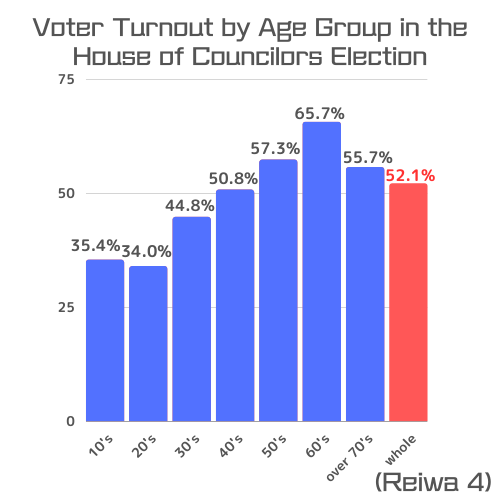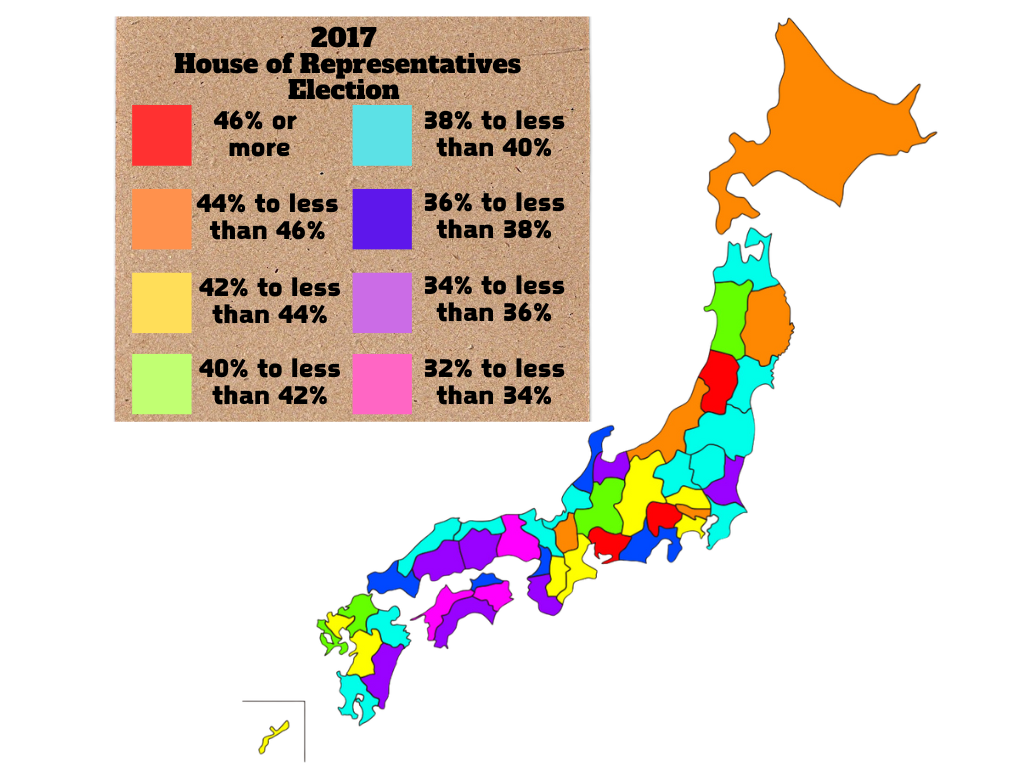Elections are held to elect people who will represent us, the people, in politics, but there are problems with such elections.
What exactly is the problem?
Decline in voter turnout
Low voter turnout!
Voter turnout is the ratio of voters to the total number of voters.
In fact, the voter turnout by age group in the House of Representatives election was 43.21% for teens, 36.50% for those in their 20s, and 47.12% for those in their 30s,
and in the House of Councillors elections, 35.42% of the respondents were in their teens, 33.99% were in their 20s, and 44.80% were in their 30s.It shows extremely low voter turnout among younger voters.
This will make it difficult for the problems and opinions of the younger generation to be reflected in politics as the society's birthrate declines and the population ages.


A closer look at the graph above shows that teenage voter turnout is higher than 20-something voter turnout.
Those who in their 20s include a wide range of ages, from 21 to 29, while the teens include only 18 and 19 years old.
Why teenage voter turnout is so high?
For more information, click here!
Factors Contributing to Declining Voter Turnout
The reasons behind young people's disengagement from politics include "going to the polls is a hassle,"
"I am not interested in elections," and "people like myself who do not understand politics should not vote,"
as well as opinions such as "elections do not change politics" and "nothing will improve if I vote".
Occurring problems
If voter turnout among young people continues to decline,a "voter = non-youth" structure will be created, leading to policies that give priority to older voters, who have higher voter turnout.
For example, if elderly voters demand better medical care and welfare, legislators who promote such policies will be elected, but the cost will be paid entirely from working-age taxpayers' money,
and the heavy taxation and reduced support for the young will further increase distrust of politics among the young, which could lead to a negative spiral of lower voter turnout.
The government is also concerned about this situation and is calling on young people to participate in politics.
counter-measure
- Change of Polling Place
- Absentee ballot
- Bringing in younger people to the operation
- Utilize the Internet
Polling places are mainly used in schools and municipal facilities, but if polling places are set up at train stations, shopping malls, or other locations close to daily life, reasons such as "it is a hassle to go to the polling place" or "I don't have time to go to the polls" can be eliminated.
The absentee voting system is a system that allows people who are staying in a municipality other than the place of registration during the election period, such as for work or travel,
to vote in the municipality where they are staying.
This also solves the problem of "I can't vote because I haven't moved my resident registration.
However, the complexity and time-consuming procedures have not been accepted by university students and working adults who have little time to spare, and the number of users is still low.
By including younger voters in the management of elections, elections will become more accessible.
Getting young people to take the initiative in elections, rather than being passive, is important for raising youth voter turnout.
Campaigning via the Internet is one effective way to increase young people's interest in elections.
You can naturally enhance your exposure to elections by campaigning on your most familiar smartphone/computer.
The following is an example from Yamagata Prefecture, where measures to address declining voter turnout have actually resulted in a higher voter turnout among young people.
In the 2017 House of Representatives election, teen voter turnout topped the nation at 47.24%.

(1) Establishment of a "Youth Quota" in the Prefectural Council
We aim to have at least one youth member (in their 20s or 30s) on all councils and other bodies that discuss specific administrative measures, and
actively reflect the opinions of young people in government.
(2) Election of children's representatives to the Juvenile Congress
The "Boys' Council," which has been in existence for 18 years, consists of junior high and high school students who live or attend school in Yusa Town.
The council is structured to discuss and decide on "junior high and high school student policies" as representatives of the youth of Yusa Town.
Children's assemblies (mock assemblies of local governments held for children in elementary schools, junior high schools, high schools, etc.) are not that rare.
However, Yamagata Prefecture, which has a remarkably high teenage voter turnout, has been taking effective measures such as voting through actual elections, and these measures are actually reflected in the city's policies,
A budget (450,000 yen) is available for policy implementation.